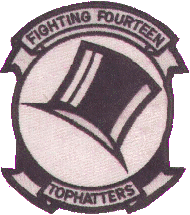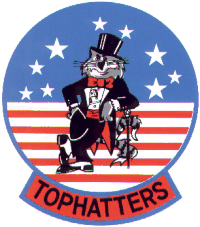
|
VF-14 Tophatters CALLSIGN: CAMELOT
CALLSIGN: CAMELOT
The history of Fighter Squadron FOURTEEN dates back almost to the origin of Naval Aviation. Its record of continous active service began in September 1919 making it hte Navy's oldest active squadron. Since its inception, the squadron has flown 24 different type aircraft, had its designation changed 14 times, operated from 17 different aircraft carriers plus several battleships, and has been commanded by 63 Naval Officers. In the past, the squadron has been assigned many different missions including patrol and observation in its early years, and scouting, attack, and fighter when associated with carrier based operations. Its carrier career started with the US Navy's first aircraft carrier, the USS Langley (CV-1) in 1926. The squadron, then designated Fighter Plane Squadron ONE, established a record for carrier landings in a single day. Flying the TS-1 aircraft, 127 traps were copleted by the end of flight operations. The Tophatters proved to be a formidable foe during WWII. While embarked in USS Ranger (CV-4), the squadron provided air support for the invasion of North Africa in November 1942. During the 4 days of November 8 - 11, pilots destroyed 16 enemy aircraft. Flying the SBD Dauntless dive bomber, the squadron participated in the first American naval air strike against German forces in Norway's inner channel. In November 1944, the squadron transferred to the Pacific Fleet and participated in the Leyte Campaign embarked in USS Bunker Hill (CV-17). Transferring to the USS Essex (CV-9), the squadron bombed fortifications on Formosa in January 1945., supported the assault on Iwo Jima in February, participated in the first naval carrier strikes on Tokyo, and completed Pacific combat operations with strikes on Okinawa in early March 1945. In 1949, the Tophatters received their current designation as VF-14 with an all weather intercept mission. In May 1963, the Tophatters transitioned to the F-4B Phantom II and on 23 January 1964, they became the first Phantom squadron to operate aboard USS Franklin D. Roosevelt (CVA-42). In June 1966, the Tophatters again joined the Pacific Fleet and conducted air strikes and supporting missions against military targets in North Vietnam. During this combat deployment, the squadron flew 1,688 hours on 967 combat sorties and delivered 651,624 pounds of ordnance, in addition to fulfilling its traditional combat air patrols and fighter escort mission. With the commisioning of USS John F. Kennedy (CV-67) in September 1968, the Navy's oldest squadron found itself on the newest carrier. After four highly succesful Mediterranean deployments, the squadron transitioned to the Navy's newest fighter, the F-14A Tomcat in January 1974. Between June 1975 and January 1976, the Tophatters deployed about USS John F. Kennedy for the first Atlantic deployment of hte F-14A. In October 1978, Tophatters aircrews set an all-time, one month F-14A flight hour record of 977 hours while deployed in the Mediterranean. Commencing local carrier operations in February 1980, Fighting FOURTEEN continued its high tradition of excellence by winning the &uot;Fighter Olympics" with the highest grades ever awarded by the VF-43 adversaries and recording a perfect (100%) kill rate with all missiles fired during Type Training and Readiness inspections. In August 1980, the Tophatters deployed to the Mediterranean Sea with Carrier Air Wing ONE aboard the USS John F. Kennedy. During this deployment, VF-14 won the Battle "E", establishing a two year hold on the coveted Battle Readiness Award. In July 1981, the Tophatters became a member of CVW-6. The squadron deployed in June 1982 aboard USS Independence (CV-62), and in July was named "Best Fighter Squadron" by Commander Fighter Wing ONE for hteir superb performance in the Atlantic Fleet Fighter ACM Readiness program (FFARP) against VF-43 adversaries. October and early November 1983 found the Tophatters logging combat time in support of operation "Urgent Fury" in Grenada. This was the squadron's first combat since Vietnam, and the first in the F-14 Tomcat. After playing an integral part in the liberation of Grenada from Cuban insurgents, VF-14 proceeded east to the Mediterranean Sea with CVW-6 to participate in contingency operations off the coast of Lebanon. In early December 1983, the Tophatters were again called upon to provide combat air patrol and fighter escort support for elements of the multi-national forces in Beirut, proving once again that the oldest active squadron is always ready to fulfill its traditional mission. On April 1, 1985, VF-14 Tophatters returned to USS John F. Kennedy and CVW-3, completing four and one-half years of successful operations with USS Independence and CVW-6. The Tophatters spent the rest of 1985 on a turnaround schedule that included eleven detachments to various parts of the USA and Canada. In June, VF-14 participated with the Air Force in RED FLAG 85-4, the most realistic overland aerial war games to date. In August, during the annual Fleet Fighter ACM Readiness Program (FFARP), VF-14 was the first to fight against the newest adversary aircraft in the Navy's inventory, teh Israeli Aircraft Industry F-21A Kfir. On August 18, 1986, the Tophatters and the USS John F. Kennedy departed on a Mediterranean Cruise which was extended for one month due to the Lebanon Hostage Crisis. Upon their return, the Tophatters completed a higly successful missile shoot as well as performing the best of any fighter squadron in hte 1987 FFARP program. In February 1988, the squadron detached to NAS Fallon, Nevada, and began extensive workup phase for the 1988 Mediterranean Cruise. While on cruise, VF-14 played a major role in several successful exercises including National Week, Operation Seawind with Egypt, joint NATO exercises, and Display Determination 88. In 1989, VF-14 was presented with the CINCLANT "Grant Slam" Award for a perfect missile firing record. The competition for the award included all East Coast fighter and fighter/attack (F/A-18) squadrons. This was the first time a Tomcat squadron won the award since the F/A-18 Hornets entered the competition. 1990 saw the squadron providing Orange Air for the USS Dwight D. Eisenhower (CVN-69) and conducting dual carrier battle operations with the USS Saratoga (CV-60). The Tophatters visited New York City during Fleet Week in June and spent the Fourth of July in Boston. The USS John F. Kennedy and CVW-3 were called upon on August 10, 1990, eight days after Iraq invaded Kuwait, in support of Operation Desert shield. The ship emergency deployed just five days later on its way to the Red Sea. During the five months leading up to combat operations, the Tophatters played an integral role in enforcing the Iraqi embargo during Desert Shield. On the morning of January 17, 1991, the Tophatters joined US forces in the air assault upon Iraq. After a short standdown, VF-14 was right back at it with a busy summer schedule. In June, six Tophatters jets flew to Homestead Air Force base to oppose F-16s in ACM training. In July, Puerto Rico was the destination, as the squadron spent 2 weeks in Roosevelt Roads in support of the USS Eisenhower Orange Air Det, while successfully firing 13 of 13 air-to-air missiles in demanding scenarios. The Tophatters closed out the summer by spending 3 weeks onboard USS Kitty Hawk (CV-63) as the ship completed work-ups before transitioning to its homeport of San Diego, California. As fall 1991 approached, the Tophatters prepared for a new and improved FFARP syllabus against VF-43, concluding the 13 hop exercise with a 13 to 3 kill ration in FFARP derby. In December 1991, with the introduction of the air-to-ground mission to the Tomcat, VF-14 began a new chapter in their long, illustrious history. After low altitude training and several strike related schools, the Tophatters tackled the Tomcat Advanced Strike Syllabus (TASS) and soon put these new found skills to work during airwing workups at NAS Fallon. Over the next several months, VF-14 completed the standard precruise operational training requirements, including deployments off the Eastern U.S. and Puerto Rico. While anchored at St. Thomas in July, the Tophatters, along with Kennedy Battle Group, were ordered on an emergency early deployment due to rising tensions in the Persian Gulf. While ordered to turn back several days later, the Battle Group again demonstrated the flexibility provided by carrier based air power. Tophatters again headed east in October for thier scheduled 92-93 Mediterranean Cruise. Once past Gibraltar, VF-14 immediately began flying air superiority mission and reconnaissance in the Adriatic in support of United Nations policies in Yugoslavia. As things there took a brief lull, VF-14 headed south to Alexandria for Operation Sea Wind 92, a joined U.S.-Egyptian training exercise. After a week of combined operations during which both countries' aircrews got an intersting look at how the "other guys" engage in air combat, it was north again to the Adriatic.  In late 1995 the squadron was detached from CVW-3 and directly assigned to Fighter Wing One at
NAS Oceana.
In late 1995 the squadron was detached from CVW-3 and directly assigned to Fighter Wing One at
NAS Oceana.
1996 saw much uncertainty for VF-14, with much debate over whether they would continue to fly the F-14 or would become VFA-14 flying the F/A-18 Hornet and helping to fill the lack of Hornet squadrons. Late 1996 saw the decision made in favour of keeping VF-14 as an F-14 squadron and the summer had seen VF-14 participate in their first cruise for several years, joining CVW-8 onboard USS John F. Kennedy for a Mediterrenean cruise which also saw a port visit to Portsmouth. While Kennedy was in Portsmouth at least one VF-14 aircraft took part in the static display of the 1996 RNAS Yeovilton airshow, along with aircraft from VF-41, VS-24, VAW-124 and VFA-15. At the same time much of the rest of CVW-8 flew in to RAF Lakenheath for an overnight stop. By joining CVW-8 the squadron restored it to two F-14 squadrons, the other being VF-41. This meant that for a short while both Atlantic and Pacific fleets had one airwing apiece that had two F-14 squadrons, rather than the now more normal one. The Pacific equivalent of CVW-8 is CVW-14, which had both VF-11 and VF-31 assigned. However with the move of VF-11 from CVW-14 to CVW-7 in early 1997 it is now only the Atlantic Fleet that has any airwings with two F-14 squadrons. VF-14 cruised as part of CVW-8 in the summer of 1997, taking their F-14A's across the Atlantic and into the Persian Gulf. In a fairly astounding piece of work the squadron was awarded the "Golden Wrench" award for this cruise-an award which goes to the squadron with the best availability record during the cruise. This is amazing because the F-14 is not the easiest aircraft to maintain, as even it's most fervant supporters will admit, and is even more impressive as VF-14 have some of the oldest airframes in the Fleet. In December of 2001 VF-14 becomes VFA-14 and transitions to the new Super Hornet FA-18E. With this transition comes a new home at NAS Lemoore, California. As always, the Tophatters will continue to dominate the skies and put bombs on target. Among the many awards held by the Tophatters are two Presidential Citations, the Navy Unit Commendation, two Meritorious Unit Commendations, 5 battle stars, and an unprecedented 3 year hold on both the CNO Aviation Safety Award and CNAL Battle Efficiency "E" for the years 159, 1960, and 1961. Fighting FOURTEEN also received the CNO Safety Award for 1978 and the CNAL Battle Efficieny "E" for 1979 and 1980. Further awards: 1999 CNO Aviation Safety Award S F-14A, 2000  F-14A  |
Top of the page |
F-14 Tomcat Squadrons: VF-74 | VF-84 | VF-101 | VF-102 | VF-103 | VF-111 | VF-114 | VF-124 | VF-142 | VF-143 | VF-154 VF-191 | VF-194 | VF-201 | VF-202 | VF-211 | VF-213 | VF-301 | VF-302 | VF-1285 | VF-1485 VF-1486 | VX-4 | VX-9 | NAWC | NATC | NFWS | NASA | Iranian Air Force Carrier Airwings | Squadron Awards F-14 Tomcat: Other Topics: Start Page Foreword FAQ Updates Copyright © by Torsten Anft |